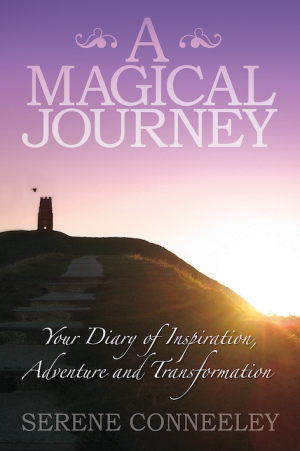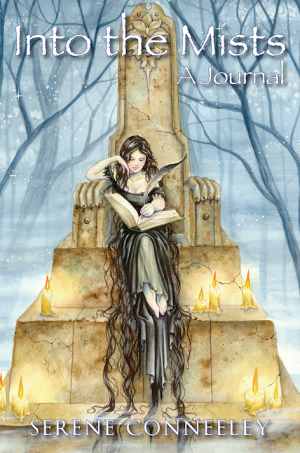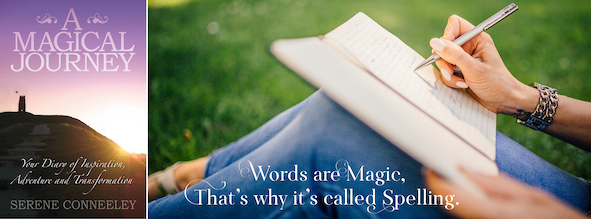 The Power of Words
The Power of Words
First published in Spellcraft – a national spiritual magazine – in 2010…
The healing impact, both physically and emotionally, of expressive writing and journalling led Serene Conneeley to create her new book A Magical Journey: Your Diary of Inspiration, Adventure and Transformation.
I’ve always loved the power of the written word. Being shy, I find it easier to express myself through writing, which probably explains why I became a journalist and author! I’ve been powerfully affected by the words of others (most of my walls are book shelves), and touched beyond belief by letters from people saying my books have brought them to tears, helped them heal or inspired them to follow their dreams.
Through writing I’ve discovered my strengths, my weaknesses and my inner self, and been able to identify patterns – in my behaviour, the people I draw to me and the treatment I put up with – and change them so I can heal myself and live a happier life. I’ve left a job and broken off an engagement after re-reading my journal, because although I was in denial at the time, the truths I’d expressed on the page revealed my unhappiness and made me realise I had to do something about these situations.

Expressive writing is a journey of self-discovery and self-knowledge, a process through which you can uncover what you believe and the ideals that are most important to you, connect with your deepest self, explore your inner psyche and allow your true essence to blossom. It’s the perfect way to connect with your own inner wisdom and begin to understand yourself and your motivations, which is at the heart of magic.
Writing is also very healing, and has been used as a form of therapy for centuries. Renowned psychologist Carl Jung encouraged his patients to keep a diary as a therapeutic tool, emphasising the value of understanding the psyche through self-exploration. Elenor Gill, author of the hauntingly beautiful novels The Moon Spun Round and In the Shadow of Trees, was originally an occupational therapist in remedial psychiatry, where she used creative writing in the treatment of mental illness. And psychology professor Dr James W. Pennebaker, who began his continuing research into the power of expressive writing decades ago, has found that journalling improves not only emotional wellbeing and cognitive abilities but also physical health.
In addition, writing can help you manifest your dreams into reality, as putting down what you want on paper brings the energy of your idea out of the etheric and into the physical, where you can make it become real. It also enables you to pinpoint exactly what you want, because you can’t make your dreams come true until you know what they are. If you’re flitting from project to project, enthusiastic at the beginning but quickly losing interest once the hard work begins, it can be worthwhile to explore, through writing, exactly what it is you want to achieve. Perhaps you do want to be a healer, but the method you’ve chosen isn’t the right one for you and you simply need to find another avenue. Maybe you’ve been pursuing a childhood dream that no longer interests you, or unconsciously following the expectations of your parents. All the answers are within you, so you just need to reveal them to your self.
To do this, try free writing. At the top of a page, write: “What I want to do with my life,” “My deepest dream,” or something similar, then set a timer for 10 minutes and start writing, as fast as you can, until it goes off. Write whatever comes into your head, regardless of how silly it sounds. Follow any tangents that come up. If you get stuck, ponder why it’s your dream and how you can achieve it. Don’t edit as you write or even think about what it all means, just let the words unfold. When the timer goes off, read back over what you’ve written. If something leaps out at you, write that at the top of a new page and repeat the exercise. The aim is to get to the heart of what you really want to do, so have the courage to dig through your fears and uncover your inner dreams.
Magical Writing
In magical terms, a Book of Shadows is the heart of your spiritual practice, a living, changing, expanding repository of the person you are now and the person you are becoming. Through recording your rituals and writing about the outcomes and consequences, as well as adding any research you’ve been doing, new knowledge or observations, you learn and grow and become stronger in your conviction and your craft.
It’s a sacred book that is imbued with your own personal energy and magic. Much of this power comes from the fact that it’s written by you, in your own words and your own way, and so it reflects you, becoming a mirror that reveals you to yourself.
“An authentic Book of Shadows must be hand-written, because a not insubstantial portion of the tradition’s power and beauty derives from the magical art of putting pen to paper,” says Judika Illes, author of The Element Encyclopedia of Witchcraft. “They are beautifully embellished works of art, power, magic and spirituality.” Adds author and magical teacher Stacey Demarco: “Writing in your Book of Shadows can help you keep track of not just how well your spells are working and the magical techniques you’re using, but how you’re growing as a witch and as a person.”
Through the process of writing you can define and explore your magical and spiritual beliefs, and gain a deeper understanding of them and their source. Witchcraft has no book of rules or defined system of belief you must adhere to, it’s about creating your own path, which will be a mix of what you’ve read, what you’ve experienced and what you’ve learned from fellow magical practitioners, friends, and even your parents and school teachers. (Some might be in reaction to things you disagree with, so you take the opposite viewpoint.) Writing about your spiritual views, what you believe and why, and whether a belief still fits with the person you’ve become or can be discarded, is an interesting exercise for your Book of Shadows or your journal.
Writing is also a powerful way to connect with the divine, be that an external deity or your own higher self, to attain wisdom. Many people feel they can channel the goddess by sitting quietly and asking a question, then allowing the word to flow onto the page. Another way to access inner guidance is to write a question about a situation or problem you’re facing with the hand you write with, close your eyes and take a few deep breaths to centre yourself, then start writing the answer with your other hand. Using your non-dominant hand connects with a different part of the brain than you usually use and accesses the subconscious, allowing you to reveal what is hidden and tap in to your intuition. When you can finally decipher the scrawl, you’ll discover some incredible pieces of wisdom you weren’t consciously aware of, which were within you all along.
The Beauty of Books
The power of writing and books to educate and empower is also important. Most magical practitioners learn at least some of their craft from books or online articles, which help you master the basics and give you the confidence to develop your own style and practice. You don’t have to subscribe to everything these authors believe in order to get something from their work, because the Craft is a personal journey, and you’re encouraged to think for yourself, explore lots of different aspects, question what you learn and develop your own system of magic and spirituality.
Works of fiction can also teach a lot and reveal hidden wisdom. Through books such as those by Juliet Marillier and Paula Brackston, you can learn about the Old Ways, about scrying, herbcraft and potions, women being strong and powerful and nurturing each other, archetypes and inner journeying. While they are fictional, there are truths woven through the stories that resonate today, inspiring your own search and acting as a catalyst for solidifying your beliefs and values. They speak of a connection to nature and of the seasons and sabbats, detail rituals and spellworkings, and create an awareness of the past and its wisdom. The tests the characters endure, the challenges they face and the rituals they perform teach readers much about themselves, while the sense of magic and poetry lifts the spirit.
Writing your own fiction, be it in book form, for friends or published on a website, and exploring the myths and legends of magic, can also help you learn, grow and express your inner heart and magical self.
Having Fun with Rhyming
A spell is, in essence, a statement of your desire, and it can be as simple or as complex as you wish. It’s usually the words that fuel the magic, and making your incantation rhyme – while not necessary – is fun, helps you remember the spell and adds power through the rhythm and intent with which you speak it.
Rhyming chants are also a great way to raise energy and attune people to the same vibration and intent for group rituals and spellworkings. It’s not the rhyme itself that boosts the outcome, but in its harmony and rhythm an oft-repeated chant brings people together energetically, creating a sense of oneness that adds oomph. And for some people, rhythm and music make it easier for them to attain a magical state of mind and prepare for group workings, or enter the necessary headspace for personal craftwork.
“I love using rhyming in ritual. It helps me connect with the heartbeat of Mother Earth, and I love it when her pulse travels through my feet and inspires my words and work,” says author Anita Revel, who uses iambic pentameter, named after the goddess Iambe and made famous by Shakespeare, in her children’s book Selena’s Crystal Balls: A Magical Journey Through the Chakras, to lift the mood and add a sense of playfulness. “Rhyming allows the left brain to cease ‘thinking’ and simply go with the flow of the rhythm that the right brain is having fun with. It’s not essential, but it certainly helps the reader connect at an emotional level with the words when they are said in time to their own heartbeat.”
Whether you’re expressing your deepest thoughts in a journal, creating a rhyming spell, channelling the goddess or composing a story, the process of writing is a powerful tool, helping you go within, access the wisdom of your own heart and express your deepest self.
Inspiring, Magical Books and Authors
Circe, by Madeline Miller. [It’s now May 2019, and this is my favourite book of the year so far, so I had to add it to this old list…] Once I started this book, all I wanted to do was keep reading, and when I finished it, I felt totally bereft. It’s the enchanting, surprising story of the legendary witch-goddess Circe. Exiled by her father, the sun god Helios, she spends the centuries planting herbs and casting spells on her remote island, living, loving, hating, grieving, learning, growing, hoping, scheming, dreaming, with occasional fascinating interactions with historical figures and deities. It’s a truly beautiful book, based in history and legend yet wholly of today in its themes..
The Sevenwaters Series, by Juliet Marillier. All the books by this amazing author are enchanting, passionate and filled with learning, but this series in particular brings the wise woman’s craft to the fore, with herbal remedies, druidic rituals and healing melding perfectly with love, war, religious battles and the realm of the fae. The first three, Daughter of the Forest, Son of the Shadows and Child of the Prophecy, were later joined by Heir to Sevenwaters, Seer of Sevenwaters and Flame of Sevenwaters.
The White Mare, by Jules Watson. From another beautiful writer with a penchant for druidic magic and the clash of the Old Ways with Christianity in the first centuries AD, this is an enchanting story about a priestess and the sacrifices she makes for her people and her land. It is the first in The Dalriada Trilogy, which includes The Dawn Stag and The Boar Stone.
The Witches of Cambridge, by Menna Van Praag. I fell in love with Menna’s book The House at the End of Hope Street when it came out, and have loved every book since, including The Lost Art of Letter Writing and The Patron Saint of Lost Souls. The Witches of Cambridge is the most witchy, and combines books, food and magic so beautifully.
And I’ll add ALL of Juliet Marillier, Paula Brackston, Alice Hoffman, Deborah Harkness and Sarah Addison Allen’s books.
The Red Tent, by Anita Diamant. This gripping imagining of Dinah, who was mentioned briefly in the Bible, brings to life the wisdom of women, the magic of herbs, the talents of midwifery and the bond between mothers, daughters and friends as they share their pain, knowledge and strength each month.
Cross Stitch, by Diana Gabaldon. The first in a sweeping saga of love, war and time travel, this follows feisty modern woman Claire, who steps into a stone circle after a pagan ritual and goes back in time to 18th century Scotland, where her knowledge of healing and the future has her branded a witch. [In 2019, Diana’s series, which began thirty years ago, has been turned into the blockbuster TV series Outlander, and she is currently working on the ninth book, Go Tell The Bees That I Am Gone, as well as related stories in this world.]
The Sea Priestess, by Dion Fortune. On one level a story of love and crisis, this is also a learning tool, with magical information and instruction woven into the tale of priestess Morgan, her Atlantean history, the deities she invokes and the rituals she enacts with a man in need of healing.
The Moon Spun Round, by Elenor Gill. A story of murder, revenge and the craft of the wise that’s striking in its depiction of strong women bound by friendship, magic and a little grey cat, and interwoven with flashes of historic witch trials, modern-day moon magic and self-realisation through connection to the goddess.
The Witch of Cologne, by Tobsha Learner. An enchanting, confronting story set in 17th century Europe, which touches on spirituality, revenge, humanism and grand passion as it details the life and loves of a young Jewish midwife and healer who is persecuted as a witch because of her mystical knowledge and strength of spirit.
The Rose Labyrinth, by Titania Hardie. After several beautiful, informative, velvet-wrapped non-fiction guides to witchcraft, Aussie witch Titania has woven her real-life magic into a novel, using Elizabethan occultist John Dee as the focal point of a mystery that sweeps through generations of women to modern times.
Serene Conneeley is a Sydney writer, healer and witch, and author of Seven Sacred Sites, Witchy Magic, Mermaid Magic and Faery Magic, and the novels Into the Mists, Into the Dark, Into the Light, Into the Storm, Into the Fire and Into the Air. Her book A Magical Journey: Your Diary of Inspiration, Adventure and Transformation is part journal, part guide, and explores the physical, mental and spiritual health benefits of journalling, provides exercises to release emotional blockages and start expressing your deepest desires and explains how to make a wish come true using the cycles of the moon and create magic in your life by harnessing the ancient, sacred energy of the seasonal turning points of the year.



Get Social